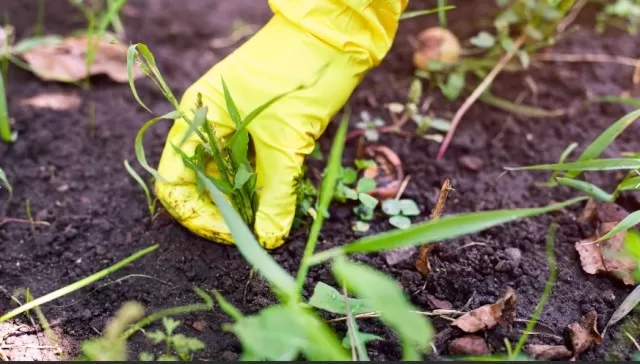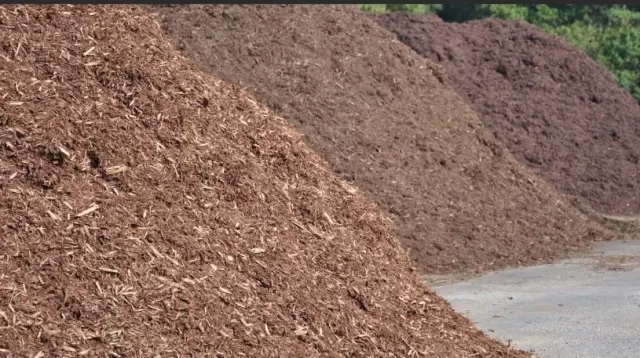Mulch 101: 13 Types and Tips for Yard Selection (Part 1).Elevate your gardening experience and ensure the health and happiness of your cherished plants while making your life easier – all with the artful selection of the perfect mulch for your landscape.
The Garden’s Guardian: How Mulch Enhances Your Outdoor Oasis

Mulch, often underestimated but truly a garden’s unsung hero, offers a plethora of benefits to your outdoor paradise.
When thoughtfully spread around your trees and landscape plantings, it plays a vital role in ensuring their well-being by keeping grass at bay, preventing it from competing for essential resources. However, the advantages of mulch extend far beyond this simple function.
As explained by Aaron Steil, a horticulturist associated with Iowa State University Extension, a well-maintained layer of mulch serves as a shield against the relentless impact of raindrops on the precious soil in your gardens and landscaped areas around your home.
With climate change ushering in an era of more intense rainfall events, this protective barrier becomes increasingly crucial for preserving the integrity of your garden beds.
Yet, the magic of mulch doesn’t end there.
Depending on the type you select, it can act as a guardian angel for your soil, enhancing its quality and vitality. This, in turn, translates into healthier and more stunning growth for everything that takes root in your garden.
From improving moisture retention to regulating soil temperature and suppressing weed growth, mulch is a multifaceted ally that ensures your garden flourishes with both resilience and beauty.
So, as you spread that layer of mulch, remember that you’re not just beautifying your garden; you’re investing in its health, resilience, and ability to withstand the changing tides of our climate.
Mulch truly stands as a silent but indispensable partner in your gardening journey.
The Diverse Composition of Mulch: From Organic Delights to Inorganic Wonders
Mulch, a vital component of garden health and beauty, can be crafted from a diverse array of materials.
At its core, mulch is made from either organic or inorganic substances. However, it’s important to note that there might be some overlap between these categories. For instance, crushed seashells and sedimentary rocks, which contain organic elements, are generally classified under inorganic mulches.
Organic mulches are primarily composed of natural, plant-based materials such as wood chips, leaves, and other plant debris.
They excel at retaining soil moisture and maintaining an optimal soil temperature during both hot and cold weather. Additionally, as organic mulches break down, they enrich the soil with nutrients, improve its structure, and enhance drainage.
While they can help suppress weed growth, they don’t completely block it.
Inorganic mulches, on the other hand, include materials like rock, gravel, and even plastic sheeting.
These mulches are especially beneficial in regions prone to wildfires, as they are less flammable than their organic counterparts. However, they tend to absorb and retain heat, which can potentially damage plant and tree roots.
While some inorganic mulches like plastic sheeting can block weeds, they also prevent water and oxygen from reaching the soil, thereby stifling the soil’s microbiome—a community of organisms that nourish plants and trees.
Despite being marketed as weed-free solutions, inorganic mulches are not foolproof.
As Aaron Steil, a horticulturist with Iowa State University Extension, points out, weeds can still sprout on top of them over time. Organic matter tends to accumulate on any type of mulch, creating a conducive environment for weed growth.
In essence, when selecting mulch for your garden, it’s crucial to weigh the benefits and drawbacks of each type, considering factors such as climate, plant types, and garden goals.
Understanding the Various Types of Mulch for Your Garden

Mulch comes in a multitude of types, each offering its own set of benefits for your garden.
Below are the most common organic and inorganic mulch options to consider:.
Organic Mulch:.
Wood Chips: Sourced from tree bark, branches, or other wood sources, wood chips are excellent at retaining moisture and regulating soil temperature.
Leaves: Fallen leaves can be gathered and used as mulch, providing nutrients to the soil as they decompose.
Straw or Hay: These materials are lightweight and help retain soil moisture, but they need to be replaced more frequently than other mulches.
Grass Clippings: Freshly cut grass clippings can be spread as mulch, offering a nitrogen-rich addition to the soil.
Compost: Compost not only enriches the soil with nutrients but also aids in moisture retention.
Pine Needles: Also known as pine straw, these are particularly useful for acid-loving plants and trees, as they slightly acidify the soil as they break down.
Inorganic Mulch:.
Rock or Gravel: These are long-lasting and won’t decompose, making them a popular choice for low-maintenance landscapes.
Rubber Mulch: Made from recycled tires, rubber mulch is durable and provides excellent weed control.
Mulch Application: A Guide to Enhancing Your Garden\’s Health
Applying mulch is a straightforward yet crucial step in maintaining a healthy and vibrant garden.
Here’s a handy guide to help you achieve the best results:.
Determine the Thickness: As a general rule, apply mulch at a depth of 2 to 3 inches.
This depth provides effective coverage to retain soil moisture, moderate temperature, and suppress weed growth. However, when using grass clippings as mulch, keep the depth to 1 to 2 inches.
Prepare the Area: Before mulching, clear the area of any weeds or debris.
It’s essential to start with a clean canvas to prevent weeds from growing through the mulch.
Create a Mulch Barrier: Avoid creating mulch “volcanos” around the base of trees, woody plants, and shrubs.
Piling mulch against their trunks or stems can attract insects, promote infections, and encourage root growth into the mulch, potentially harming your plants. Instead, leave a few inches of open space around the base of these plants to allow for proper air circulation.
Apply Evenly: Distribute the mulch evenly across the designated area.
Using a rake or garden fork can help you spread it uniformly. Be cautious not to smother the plants with excessive mulch, especially around the base.
Avoid Mulch Direct Contact: Ensure that the mulch does not come into direct contact with the stems or trunks of your plants.
Leave a small gap, typically a few inches, to prevent moisture buildup and potential pest and disease issues.
Maintain Proper Edging: To maintain a tidy appearance, consider edging the mulched area to prevent it from spilling onto walkways or lawn areas.
Replenish as Needed: Over time, organic mulch will naturally break down.
To maintain its effectiveness, replenish it as necessary, typically on an annual basis. This helps in retaining its moisture-retaining and weed-suppressing properties.
By following these steps, you’ll not only protect and nourish your garden but also enhance its overall health and appearance.
Proper mulch application is a simple yet essential practice that can significantly benefit your outdoor space.
“The Garden’s Guardian: How Mulch Elevates Your Outdoor Haven”

Mulch, often the unsung hero of gardens, bestows a multitude of blessings upon your outdoor sanctuary.
When thoughtfully applied around your trees and landscape plantings, it takes on the role of a dedicated guardian, ensuring their well-being by preventing the encroachment of grass and competition for essential resources. Yet, the virtues of mulch extend well beyond this primary function.
As elucidated by Aaron Steil, a distinguished horticulturist affiliated with Iowa State University Extension, a meticulously maintained layer of mulch acts as a stalwart shield, mitigating the relentless impact of raindrops on the precious soil within your garden and the landscaped areas encircling your abode.
In an era marked by the intensification of rainfall due to climate change, this protective barrier assumes greater significance, preserving the integrity of your cherished garden beds.
However, the enchantment of mulch knows no bounds.
Depending on the variety you choose, it possesses the power to transform into a benevolent benefactor for your soil, enriching its quality and vitality. This, in turn, begets healthier and more resplendent growth for every botanical resident of your garden.
By enhancing moisture retention, regulating soil temperature, and quelling the insurgence of weeds, mulch proves itself as a versatile ally, ensuring that your garden flourishes with both tenacity and beauty.
So, as you diligently lay down that comforting quilt of mulch, remember that you’re not merely adorning your garden with aesthetic allure; you’re making a profound investment in its health, resilience, and capacity to navigate the shifting tides of our evolving climate.
Mulch stands as a silent yet indispensable companion on your gardening odyssey, a guardian that silently nurtures the very essence of your outdoor haven.
*The information is for reference only.